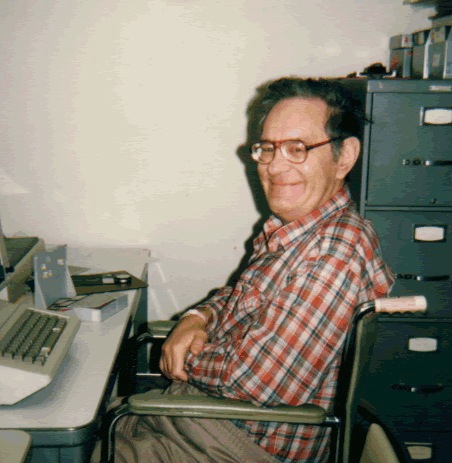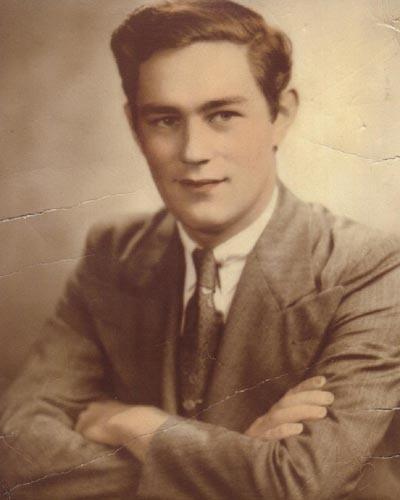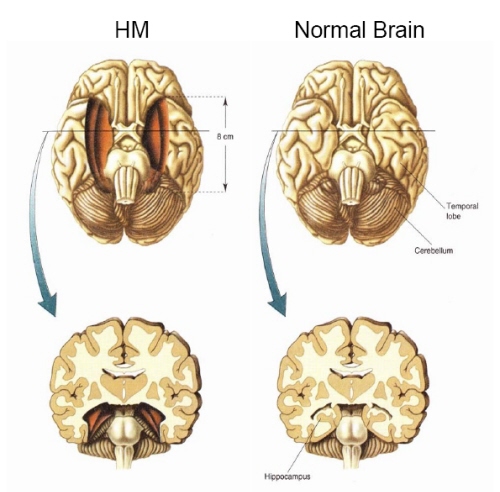This is a very well written and interesting review of a recent book on patient H.M. (Henry Molaison), whom you cannot help but to learn about in Intro Psych, Biopsych, Neuropsych, etc. Hint: He's the guy without the hippocampus who couldn't form new memories. See also this post, which suggests that HM's doctors probably caused his unnecessary brain damage..
Memory creates our identity, but it also exposes the illusion of a coherent self: a memory is not a thing but an act that alters and rearranges even as it retrieves. Although some of its operations can be trained to an astonishing pitch, most take place autonomously, beyond the reach of the conscious mind. As we age, it distorts and foreshortens: present experience becomes harder to impress on the mind, and the long-forgotten past seems to draw closer; University Challenge gets easier, remembering what you came downstairs for gets harder. Yet if we were somehow to freeze our memory at the youthful peak of its powers, around our late twenties, we would not create a polished version of ourselves analogous to a youthful body, but an early, scrappy draft composed of childhood memories and school-learning, barely recognisable to our older selves.
Something like this happened to the most famous case of amnesia in 20th-century science, a man known only as ‘H.M.’ until his death in 2008. When he was 27, a disastrous brain operation destroyed his ability to form new memories, and he lived for the next 55 years in a rolling thirty-second loop of awareness, a ‘permanent present tense’. During this time he was subjected to thousands of hours of tests, of which naturally he had no recall; he provided data for hundreds of scientific papers, and became the subject of a book (Memory’s Ghost by Philip Hilts) and a staple of popular science journalism; by the 1990s digital images of his uniquely disfigured hippocampus featured in almost every standard work on the neuroscience of memory. Since his death his brain has been shaved into 2401 slices, each 70 microns thick, compared in one account to the slivers of ginger served with sushi. Suzanne Corkin, an MIT neuroscientist, first met him in 1962 and after 1980 became his lead investigator and ‘sole keeper’. Permanent Present Tense is her account of Henry Gustave Molaison – his full identity can finally be revealed – and the historic contribution he made to science.
Corkin had a reputation for strict policing of access to Henry, a charge she happily concedes: ‘I did not want him to become a sideshow attraction – the man without a memory.’ After the death of his mother, his last thirty years were spent at a Connecticut nursing home in strict anonymity, with staff sworn to secrecy and filming prohibited. More than a hundred carefully screened researchers were admitted over the years to perform brain scans and cognitive tests, but were never told his name. Corkin’s lucid, well-organised telling of Henry’s story merges intimate case history with an account of the current scientific understanding and how it was reached.
Henry’s surgery was undertaken in an era of freewheeling experiment in pursuit of the idea that memories were indelible snapshots of sense experience, stored in chronological sequence like the frames of a celluloid film. Over the course of his decades as a test subject, the field was colonised by information theory, the processes of memory divided like those of a computer into encoding, storage and retrieval. Now the post-mortem scanning and mapping of Henry’s brain is exposing the artificiality of these divisions and revealing complexities that no computer can emulate.
Henry had his first epileptic episode in 1936, at the age of ten; by 1953 his seizures had become increasingly frequent and debilitating. His family doctor referred him to William Beecher Scoville, a leading neurosurgeon at Yale Medical School. When massive doses of medication failed to quell his attacks and EEGs revealed no obvious locus of brain damage, Scoville suggested a novel surgical procedure. Using a trepanning drill he had constructed himself from auto parts, he cut two coin-sized holes in the skull, ‘doorways to Henry’s brain’, and suctioned out most of his medial temporal lobes, the front half of the hippocampus and most of the amygdala. After recovery, Henry’s seizures were significantly reduced, but it soon become apparent that the operation had vacuumed away any recollection of his hospital stay, and indeed most of the significant events of the previous few years. Catastrophically, it had also created a global anterograde amnesia: the loss of the ability to form new memories of any kind.
The holes that Scoville cut to expose Henry’s brain to his instruments stand as a grisly metaphor for the science that underpinned the operation: small patches of illumination surrounded by an uncharted expanse of darkness. In 1953 the hippocampus was believed merely to support the sense of smell: its role in memory was unsuspected. Yet neurosurgery seemed to be banishing the darkness at an astonishing rate. The inspiration for Scoville’s work was the Canadian surgeon and researcher Wilder Penfield, who had pioneered surgical interventions for epilepsy at McGill University in the 1930s. Penfield had discovered that by moving an electrode over the brains of patients while they were conscious under local anaesthesia he could sometimes identify the source of their seizures. But the technique also produced some unexpected, even miraculous responses. As the electrode passed across the temporal lobes, patients would twitch, vocalise and describe strange sensations, and some would experience intense ‘flashbulb’ memories such as childhood scenes or long-forgotten songs.
By plotting the sites that provoked these responses, Penfield generated brain maps that led him to new theories of ‘functional localisation’. Lavishly funded, first by the grateful families of patients whose epilepsy he had relieved and later by the Rockefeller Foundation, he expanded from remedial surgery into an intoxicating programme of research, teaching and experiment. His operating theatre was customised with cameras and EEG facilities, and he worked intensively with his ‘memory patients’ to harvest their recollections and match them to the moment of their formation. All experience, he came to believe, was perfectly preserved in memory, and perfectly recoverable: a ‘library of many volumes’, organised in an orderly record along ‘the thread of time’.
Penfield’s work suggested to Scoville that Henry’s seizures might be localised in his temporal lobes, but it also exposed the risks of operating on them. By 1953 Penfield had established a standard procedure for epileptic patients: the partial temporal lobectomy, in which the cortex of the temporal lobe was removed along with deeper tissue from the amygdala and the hippocampus. The procedure’s success rate was impressive, but in two patients, ‘F.C.’ and ‘P.B.’, it had for some reason produced severe amnesia. Extensive cognitive testing on the pair had begun to sketch the role of the hippocampus in memory formation; but should these alarming and unpredicted cases have stayed Scoville’s hand? Corkin accepts that the dangers and abuses of psychosurgery were becoming more conspicuous by the early 1950s but cautions against condemnation with hindsight: ‘Scoville arguably saved Henry’s life, even if he took his memory.’
It seems Scoville’s judgment on himself was harsher. His grandson, writing about Henry’s life and death for Esquire in 2010, characterised Scoville in his early career as a risk-taker with a love of fast cars, a history of daredevil medical-school stunts, a disdain for Freudian theory and bottomless confidence that the brain sciences were on the point of overturning it: the stereotype of the postwar neurosurgeon. But he never repeated the procedure, and in later life admitted it had been ‘a tragic mistake’. By the 1970s he was arguing against neural implants on the grounds that ‘we are more aware of the disastrous effects that sometimes occur in neurosurgery.’
For the long remainder of his life Henry was blandly unaware of his own story. He would readily volunteer that he had ‘a lot of trouble remembering things’; if pressed, he might speculate that ‘I have possibly had an operation or something.’ His short span of consciousness led to repetitive behaviour – making the same observation repeatedly, or mechanically eating two lunches in a row – but his conversation was characterised by a gentle wit and quizzical, punning exchanges that seemed to test every statement for possible meanings. (When Corkin commented on Henry’s love of crosswords by dubbing him ‘the puzzle king’, he responded: ‘I’m puzzling!’) He had occasional episodes of frustration, anger or panic, but was usually good-natured and accepting of the scene around him. In many respects he displayed the serenity and detachment promised by the Buddhist ideal of living in the now, freed from regrets about the past or anxieties for the future. He was certainly more content than his most extreme opposite, Solomon Shereshevsky, the subject of A.R. Luria’s The Mind of a Mnemonist. Shereshevsky’s inability to forget became a life-destroying torment. ‘The trail of memory can feel like a heavy chain,’ Corkin observes, ‘keeping us locked into the identities we have created for ourselves.’ Henry was, by contrast, ‘free from the moorings that keep us anchored in time’, though Corkin also wonders whether his lack of anxiety and emotional churn might have been related to the partial loss of his amygdala.
It was fortunate that Henry’s condition allowed him to tolerate without complaint the lifetime of intensive testing that makes up a large part of Corkin’s book: physical scans that progressed from EEG to CT to MRI, and cognitive tests of everything from memory and attention span to reaction, IQ, image recognition, maze-learning, reflex conditioning, perceptual learning, pain tolerance and language fluency. Although he responded to each test as if it were his first, he may have developed a vague undertow of déjà vu; he once remarked to a researcher with characteristic drollery: ‘You just live and learn. I’m living, you’re learning.’ Yet some aspects of his inner life remained mysterious. Did he, for example, remember his dreams? He would often recount them if prompted on awakening, but Corkin suspects that they were confabulated: real dreams must have taken place beyond his thirty-second window of recall. EEG monitoring showed that he reported dreams from both REM and non-REM periods of sleep, and his brain damage may have meant that he never dreamed at all.
Unwittingly snatching ‘dreams’ from the recesses of his waking mind was consistent with the ways Henry, always intelligent and perceptive, became adept at filling the gaps in his memory with hunches and canny guesswork. Sometimes this would baffle his researchers: one day he astonished Corkin by knowing that he was in the MIT laboratories, only to reveal that he had deduced his location from a passing student’s sweatshirt. When asked a question beyond the reach of his memory, he would often pause and then reply, ‘I’m having an argument with myself’: a range of possible answers would come to him, whether from intuition, partial recall or informed guesswork, but he would have no means of deciding between them. Although he was unable to recall specific events, regular routines would prompt him in ways that eluded conscious recognition: walking a familiar route, he might turn the correct way without knowing he had done so. A situation that recurred often enough seemed to create a ghostly outline. In 1977, after the death of Henry’s father, a lab researcher noticed that he kept in his wallet a handwritten note to himself – ‘Dad’s dead’ – to anchor his recurring feeling of absence.
Over five decades, Henry established himself as the experimentum crucis for an emerging model of mind; as Corkin puts it, ‘the purity of his disorder made him a perfect focus for the investigation of memory mechanisms in the human brain.’ Time and again he provided proof that memory was a complex of circuits and systems, each underpinned by substrates in different brain areas. His short-term memory functioned normally, except that he lacked any means of preserving it; it could be extended briefly beyond its thirty-second span with tasks such as repetitions and calculations that used his working memory, or ‘mental workspace’. His episodic memory was almost non-existent even of his life before the operation: it turned out to be a bricolage of familiar routines, locales and characters rather than specific incidents. His semantic memory – facts about the world, as opposed to incidents in his life – was stronger: while he could not recall any of his childhood birthdays, he could rehearse the events of the Wall Street crash of 1929. He could acquire new forms of procedural memory such as motor skills, and adapted happily to using a walking frame in later life. He showed that declarative memory – the storage and retrieval of facts – was dependent on the hippocampus. Non-declarative memory – ‘knowing how’, rather than ‘knowing that’ – functioned independently of the temporal lobe structures he had lost.
Henry’s death in 2008 triggered an elaborately planned logistical operation. His body was transferred from its hearse to an MRI scanner, where a vast 11 gigabytes of brain images were taken, then rushed to Massachusetts General Hospital for autopsy, where Scoville’s trepanation holes were still faintly visible as the skull was lifted away from ‘the most famous brain in the world’. After 53 hours of dissection, live-streamed on the web, its slices were frozen and preserved in a block of gelatin for microscopic examination; a digital version rotates in high-resolution 3D on a dedicated website. But this neuronal level of resolution is no longer expected to hold all the answers. Wilder Penfield’s vision of each cell ‘containing’ a memory or percept has long been abandoned, and the computer-based model of domain-specific storage is increasingly qualified by the language of ‘emergent properties’ and the ‘system as a whole’. As Corkin observes, ‘we have learned – initially from Henry – that memory does not reside in one spot in the brain.’
In life, too, the world’s most studied memory retained its inscrutable aspects. From time to time Henry would inexplicably form new memories: ‘little islands’, as Corkin calls them, ‘like driftwood washing up from an empty sea’. He would suddenly know what contact lenses were, or recall that Skylab was ‘a docking place in space’ where people were weightless. These anomalies may perhaps indicate that the vestigial stumps of Henry’s hippocampi were occasionally able to flicker into life; or they may hint at unknown levels of neuroplasticity that allow the brain to reassign tasks from its damaged regions; or they may simply have been inspired hunches, arrived at in ways impossible to describe or repeat, and invisible to the finest biological scrutiny.
Henry Molaison was memory’s sacrificial martyr, though he remained largely unaware both of his own suffering and of the ways in which it was being turned to the common good. In life, he was a stranger to himself; in death, his brain is the closest that science approaches to a saint’s relic. The triumphant unveiling of memory’s secrets is inseparable from the double violation of his identity: first the act by which his memory was taken, and then the long process whereby it became the property of all the world but him. Since his death, Corkin tells us, ‘I have dedicated my work to linking 55 years of rich behavioural data to what we will learn from his autopsied brain.’ Her account is not sentimental. She celebrated his birthdays and treasured the craft works he gave her, while recognising that he could never have felt more than ‘a vague sense of familiarity for me’. When colleagues commiserated with her after his death she reminded herself that ‘my interest in Henry … had always been primarily intellectual; how else would I explain why I had stood on a chair in the basement of Mass. General, ecstatic to see his brain removed expertly from his skull?’



No comments:
Post a Comment
Note: Only a member of this blog may post a comment.